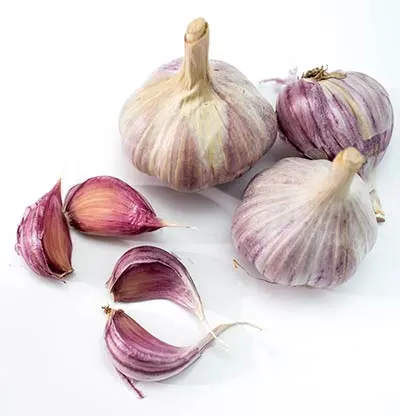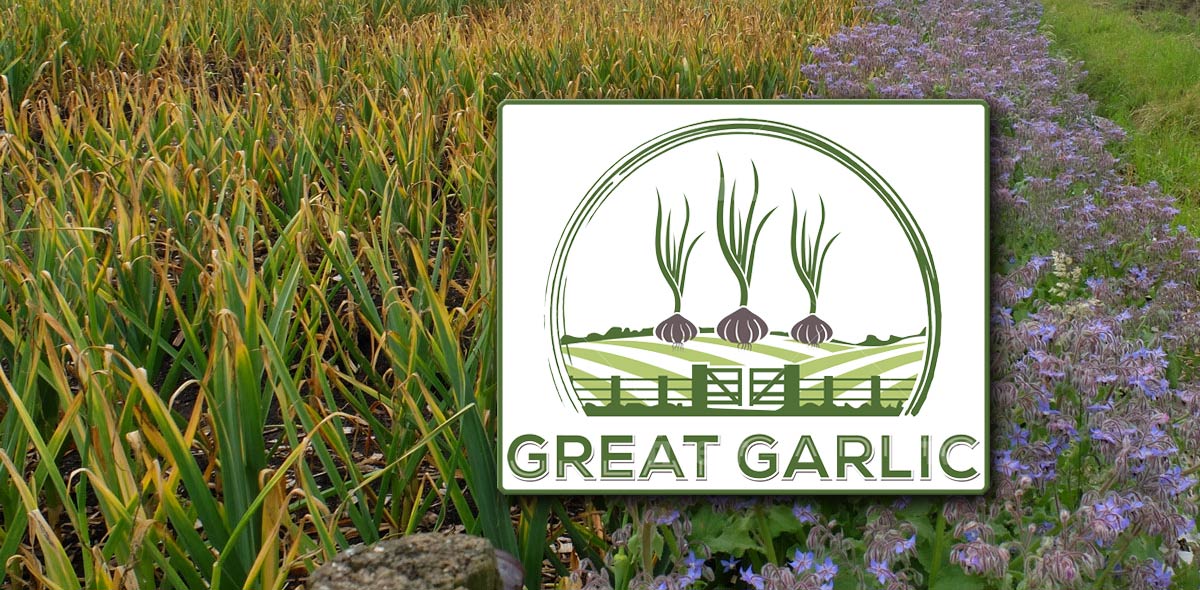In this article we will highlight some of the health benefits of garlic, compare industrial garlic production with sustainable, organic methods revealing striking differences that have far-reaching implications—not just for the environment, but for your health and the overall quality of the garlic. We’ll also feature a profile on a local farmer’s organic practices. We like to promote local, small organic farmers. Where possible look for these types of farmers in your area.
Health Benefits of Garlic
 It’s hard to pinpoint an exact number of published studies because the term “studies” can encompass a wide range of research—from in vitro and animal experiments to clinical trials and epidemiological surveys—but here’s a rough overview based on what academic databases reveal according to a search by ChatGPT:
It’s hard to pinpoint an exact number of published studies because the term “studies” can encompass a wide range of research—from in vitro and animal experiments to clinical trials and epidemiological surveys—but here’s a rough overview based on what academic databases reveal according to a search by ChatGPT:
General Garlic Research: A search on major scientific repositories like PubMed using keywords such as “garlic” and “health benefits” tends to return several thousand articles. In broad terms, you might find anywhere from 4,000 to 8,000 publications when you include all types of research (preclinical, animal studies, and clinical trials). This vast body of literature reflects garlic’s longstanding use in traditional medicine and its contemporary evaluation as a functional food.
Aged Garlic Extract (AGE) Specific Studies: When you narrow the focus to studies specifically investigating aged garlic extract, the numbers are lower—likely ranging from 200 to 500 studies. This subset generally includes clinical trials, systematic reviews, and mechanistic studies that probe AGE’s effects on cardiovascular health, immune function, and antioxidant activity.
These ballpark figures illustrate not only the depth of research into garlic’s myriad health benefits but also underscore how garlic remains a subject of active scientific interest. Do keep in mind these numbers are in constant flux as new research is published, and the exact figures can vary depending on the search criteria you use in a given database.
Several peer-reviewed studies and comprehensive reviews I’ve chosen have highlighted garlic’s impressive health benefits. Here’s an overview of the key findings from some of these studies:
1. Antioxidant, Antimicrobial, and Anticancer Properties:
A review published in Nutrition Research Reviews (2011) explores how garlic’s bioactive sulfur compounds—especially allicin—play a central role in its health benefits. This review details that garlic can inhibit low‐density lipoprotein (LDL) oxidation, support the body’s antioxidant defenses, and even interfere with processes involved in carcinogenesis. In essence, regular garlic consumption has been linked to improved cardiovascular profiles and a potential reduction in cancer risk.
2. Cardiovascular Health:
The National Center for Complementary and Integrative Health (NCCIH) summarizes several studies that suggest garlic supplementation might modestly lower total and LDL cholesterol levels as well as reduce blood pressure in individuals with hypertension. Although the effects are often modest, these changes support garlic’s role as an adjunct in managing cardiovascular risk factors, emphasizing its part in an overall heart‐healthy diet.
3. Immune System Support and Other Benefits:
In a popular overview article, Healthline details research that has found aged garlic extract (AGE) to be associated with enhanced immune function. Some studies suggest that supplementation with AGE may help reduce the frequency and severity of common colds, possibly due to improved modulation of immune cell activity and reduced inflammation. Alongside immune support, garlic’s low-calorie nutrient profile and antimicrobial properties further compound its role in promoting general wellbeing.
Collectively, these studies provide compelling evidence that garlic is not just a flavorful addition to the diet but a potent natural agent for supporting cardiovascular health, offering antioxidant protection, and enhancing immune function.
References:
- Cambridge Core – “Garlic in Health and Disease” Nutrition Research Reviews, 2011: A comprehensive review that details garlic’s bioactive compounds and their roles in antioxidant, anticancer, and cardiovascular protective mechanisms.
- National Center for Complementary and Integrative Health (NCCIH) – “Garlic: Usefulness and Safety“: This resource outlines clinical findings on garlic’s modest benefits in managing cholesterol levels, blood pressure, and blood sugar.
- Healthline – “11 Proven Health Benefits of Garlic“: This article provides a well-rounded summary of garlic’s benefits, including its effects on immunity, cholesterol, and blood pressure.
Industrial Garlic Production vs Organic Methods
Comparing industrial garlic production with sustainable, organic methods reveals striking differences that have far-reaching implications—not just for the environment, but also for consumer health and the overall quality of the garlic.
Soil Health and Nutrient Integrity
Organic Practices:
Organic garlic farming emphasizes building robust soil life through methods like cover cropping, crop rotation, and no-till or no-dig farming. In the local farmer’s approach, cover crops (such as fall rye, crimson clover, and fava beans) not only suppress weeds but also enrich the soil with organic matter and essential nutrients, fostering a thriving community of microorganisms. These practices maintain soil structure and preserve its natural fertility, helping garlic accumulate higher levels of natural bioactive compounds like allicin. Additionally, propagation from bulbils, although slower, plays a crucial role in minimizing disease transfer, thereby ensuring the crop remains healthy and potent1.
Industrial Methods:
In contrast, industrial garlic production—especially in regions that rely heavily on chemical inputs—often depends on synthetic fertilizers and pesticides to boost yields and ensure a uniform product. While this approach can result in large volumes of garlic with a consistent appearance, it tends to degrade soil health over time. Intensive chemical use can disrupt the soil’s microbial balance and reduce organic matter, potentially diminishing the nutritional content and natural flavor profile of garlic. Furthermore, to meet market demands, manufacturers may rely on post-harvest chemical treatments that help extend shelf life, which raises concerns about residual chemicals in the final product2.
Nutritional Quality and Bioactive Compounds
Organic Practices:
The symbiotic relationship between organic soil management and crop health is profound. Well-maintained soil nurtures garlic’s capacity to develop high levels of beneficial sulfur compounds. The absence of synthetic chemicals also means that the garlic’s natural defensive and nutritional chemicals are not suppressed, offering consumers a product richer in antioxidants and other phytochemicals. This has been linked to garlic’s reputed benefits for cardiovascular support, immune modulation, and even anticancer properties1.
Industrial Methods:
Industrial garlic, while perfectly safe to eat under regulated conditions, may face challenges in optimizing the natural synthesis of these bioactive compounds. The heavy reliance on chemicals can stress the plant in ways that lead to lower levels of these naturally occurring compounds. Even under strict food safety regulations, consumers have expressed concerns over the potential residual chemical inputs and the long-term effects of such practices on both human health and environmental sustainability2.
Environmental and Economic Impacts
Organic Practices:
Sustainable farming not only champions the health of the crop but also supports environmental stewardship. Practices such as crop rotation and no-till farming help sequester carbon and reduce erosion, contributing to long-term ecosystem resilience and lower greenhouse gas emissions. Additionally, local organic garlic production fosters food security and supports local economies, reducing the environmental costs associated with long-distance transportation1.
Industrial Methods:
Large-scale industrial garlic operations often prioritize speed and yield over sustainability. While this method might fulfill immediate market demands, it can lead to long-term issues such as soil depletion, increased erosion, and contamination of local water sources due to runoff of synthetic chemicals. These environmental costs, although sometimes less visible on the supermarket shelf, can have profound implications for the broader ecosystem and ultimately for public health2.
Conclusion
Organically grown garlic benefits from farming practices that promote both soil health and the synthesis of valuable phytochemicals. These methods not only yield a superior product in terms of flavor and nutritional profile but also support long-term environmental sustainability and local economies. Meanwhile, industrial garlic production—predicated on chemical intensification—can compromise soil integrity and reduce the naturally occurring health benefits of garlic.
Knowing the source of your garlic matters. Sustainable practices aren’t just about “green” ideals; they fundamentally affect the nutritional profile and safety of the food on our plates.
References
- National Center for Appropriate Technology (NCAT). “Garlic: Organic Production” – A comprehensive resource on organic garlic production methods, covering aspects from organic fertility management to the benefits of practices like cover cropping and no-till agriculture.
- AGDAILY. “Debunking 6 garlic myths: The truth behind imported garlic …” AGDAILY explores common misconceptions around imported garlic and touches on aspects related to chemical use and post-harvest treatments in industrial practices.
Locally Grown Garlic
 Great Garlic farming methods stand out as a model of sustainable, health-focused agriculture. Their approach is deeply rooted in practices that build and protect soil health—a critical factor for growing garlic with robust flavor and maximum nutritional benefit. Here’s a breakdown of their key practices and why they matter:
Great Garlic farming methods stand out as a model of sustainable, health-focused agriculture. Their approach is deeply rooted in practices that build and protect soil health—a critical factor for growing garlic with robust flavor and maximum nutritional benefit. Here’s a breakdown of their key practices and why they matter:
1. Cover Cropping and Crop Rotation
By using a diversified mix of cover crops like fall rye, crimson clover, and fava beans, the farmer is replenishing organic matter and nitrogen in the soil while suppressing weeds and preventing erosion. This practice not only feeds the beneficial fungi and microbial bacteria essential for nutrient cycling but also creates a dynamic ecosystem that reduces the buildup of pathogens. The three-crop rotation, with successive cover crops between each garlic harvest, is a proven method to break disease and virus cycles. In contrast, conventional garlic farming—often dependent on chemical fertilizers and pesticides—can lead to long-term degradation of soil quality and increased risk of contamination.
2. No-Till/No-Dig Farming Practices
The decision to adopt a no-till or no-dig system is particularly notable. Tilling the soil can disrupt and even destroy the beneficial microorganisms that help recycle nutrients and sequester carbon. No-till farming preserves soil structure, enhances water retention, and helps immobilize carbon within the soil—a factor that not only contributes to climate change mitigation but also results in a healthier growing medium for garlic. Numerous studies have highlighted how reducing soil disturbance improves microbial diversity and overall soil health, ultimately leading to higher quality, more nutrient-dense crops.
3. Raising Garlic from Bulbils
An innovative aspect of this farmer’s operation is the use of bulbils rather than relying solely on cloves. While growing from bulbils requires a longer time to maturity—three to five years—it significantly reduces the risk of passing along diseases and viruses common to garlic. This method, although slower, often results in larger and healthier bulbs, as the virus load is minimized from generation to generation. Healthier bulbs likely retain more of the bioactive compounds (such as allicin and other sulfur compounds) that are responsible for garlic’s well-documented health benefits.
4. Comparisons to Conventional Practices
Industrial farming methods in parts of China, for example, often rely heavily on chemical inputs that not only pollute waterways and degrade farmland quality but compromise the purity of the garlic itself. By implementing organic, biodynamic methods, this local farmer avoids these pitfalls, ensuring his garlic is produced in an environment with significantly lower exposure to harmful pollutants. This sustainable approach enhances the nutritional profile of the garlic, making it a superior choice from a health perspective.
Supporting Studies and References:
1. Dialogue Earth on Eco-Farming Practices: An article from Dialogue Earth discusses the detrimental impact of chemical fertilizers and pesticides in garlic farming areas in China—highlighting the environmental benefits of eco-farming methods similar to those practiced by the local farmer1.
2. Impact of Water Pollution on Agriculture: Research published in Environmental Science and Pollution Research analyzes the effects of water pollution (stemming largely from heavy chemical use) on agricultural yields and sustainability, indirectly reinforcing the need for more organic practices2.
3. Lake Protection and Agricultural Runoff: An article from China Development Brief outlines how traditional garlic farming practices contribute to environmental degradation in regions like Dali, underlining the advantages of locally sourced, sustainably grown garlic5.
4. Health Benefits of Garlic: Reviews from sources such as Healthline and Cambridge illustrate the importance of garlic’s bioactive compounds for human health. Maintaining healthy soil practices helps ensure that these compounds are present in their natural potency, free from chemical contamination3,4.
In conclusion
Great Garlic’s multifaceted approach—spanning cover cropping, crop rotation, no-till practices, and propagation from bulbils—creates an optimal environment for growing garlic that is both healthier for the consumer and more sustainable for the ecosystem. Their methods not only yield a product rich in beneficial nutrients but also avoid the pitfalls of chemical dependence that are prevalent in many large-scale operations abroad. This approach directly contrasts with the industrial practices that are often linked to environmental and health concerns. For more information or to order garlic from the farm you can visit their website and blog @ https://greatgarlic.ca/
References:
- https://dialogue.earth/en/pollution/10178-garlic-village-experiments-with-eco-farming/
- https://link.springer.com/article/10.1007/s11356-020-11079-2
- https://www.healthline.com/nutrition/11-proven-health-benefits-of-garlic
- Rana SV, Pal R, Vaiphei K, Sharma SK, Ola RP. Garlic in health and disease. Nutrition Research Reviews. 2011;24(1):60-71. doi:10.1017/S0954422410000338
- https://chinadevelopmentbrief.org/reports/lake-protection-plan-a-raw-deal-for-dali-garlic-farmers/








